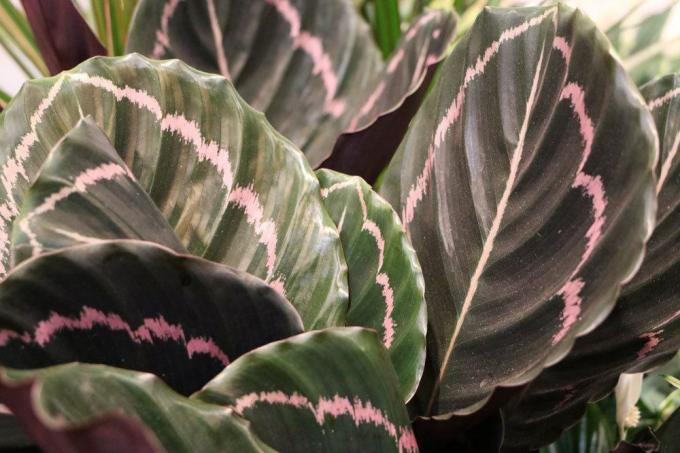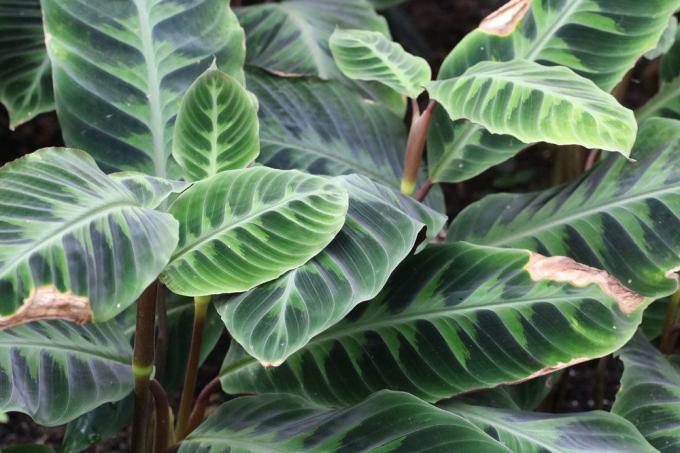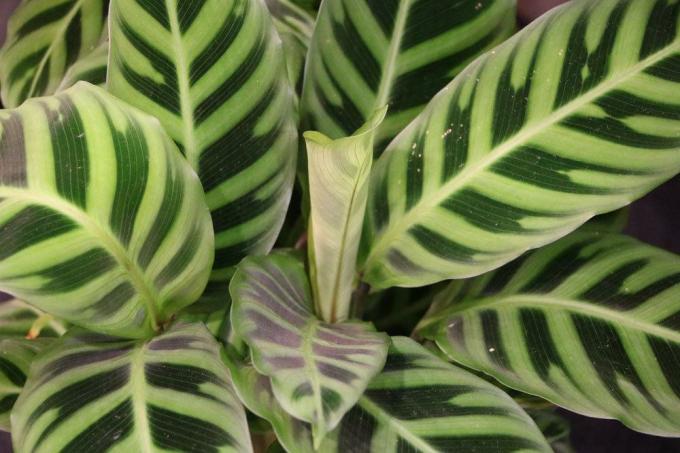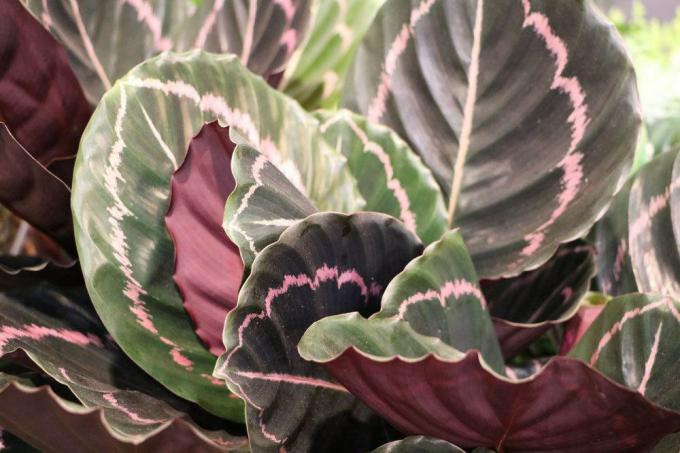
table of contents
- sorts
- Danger
- Toddlers
- First aid
- Pets
- Cats
- dogs
the Basket margin belongs to the family of arrowroots (Marantaceae) and originally comes from the Brazilian rainforests of South America. It is a beautiful ornamental foliage plant and impresses with its special and versatile marbled leaves. Are the different types of basket marante poisonous and what should you watch out for with small children and pets? We clarify all of these questions for you in this plant expert article.
sorts
The basket marante, botanically called Calathea, is a foliage plant that is mainly kept as a houseplant in this country. Basket marants originally come from subtropical rainforests and therefore need a light to partially shaded location. They feel most comfortable at a constant temperature of over 20 degrees Celsius.
The most popular varieties of the over 300 species include:
- Calathea rufibarba
- Calathea lancifolia
- Calathea crocata
Calathea rufibarba
The home of the Calathea rufibarba are the rainforests of South Africa. The leaves of the plant are dark green on the top and purple red on the underside. Its yellow flowers grow out of the earth. The Calathea rufibarba is not poisonous. So it's the ideal houseplant for families and pet owners.

Calathea lancifolia
The Calathea lancifolia is at home in the rainforests of Brazil. Its olive-green leaves are slightly wavy and have dark green markings. The underside of the leaves is purple. As a houseplant, however, it is difficult to make to flower. The Calathea lancifolia is one of the non-toxic houseplants.
Calathea crocata
The Calathea crocata comes from the rainforests of Brazil. Its leaves are dark green on the upper side and brown-red on the underside. It produces orange flowers in January and February. Calathea crocata is non-toxic to humans and animals.
Calatheen impress with their white to yellow-orange flowers or with their leaves. Although they are somewhat more demanding in terms of care than other indoor plants, they can also be kept in family households or households with animals. A partially shaded spot is the ideal location for a calathea. Also make sure that the plant receives enough humidity.
Tip: Spray the plant repeatedly with lime-free water. Setting up bowls with water also increases the humidity in the living rooms.

Danger
Toddlers
Babies and children
Babies and children are curious and spontaneous. In nature, many plants with their colorful berries attract children to snack. Also, tasting small pieces of plant leaves is one of the tests of courage in children. And faster than you can see, a piece of paper is torn off and put into the child's mouth. When babies crawl or have already started to walk, nothing is usually safe from them. Indoor plants are also a danger to babies, because many popular indoor plants are poisonous for babies and children.
If babies or children live in the household, the green plant decorations should be chosen carefully. If plants that are poisonous for babies or children are already available, they should be located outside the reach of the little ones. If you want to be on the safe side, it's best to give the plants away. The basket marante is one of the harmless houseplants.

Tip: Explain to the child why they are not allowed to “just try” plants. From the 4th At the age of 16, the child should understand your concerns.
First aid
If your child or baby has tasted a poisonous plant, stay calm in the first place. Give the child juice, water or tea to drink, no milk or saline solution. Also, don't try to make the child vomit. Keep the plant remains for the doctor. take them with you. If the poisonous plant has been clearly identified, take a branch or the whole plant with you if you do not know the exact name of the plant. The more precisely the doctor can determine the plant, the more precisely he can treat the child or baby.
Pets
Our pets, including carnivores, like to nibble on houseplants. Some even like to eat certain houseplants. Unfortunately, many pets cannot tell the difference between poisonous and non-poisonous plants. A review of the database of the Berlin Poison Information Center at the Charité has shown that basket marants are not poisonous for pets.

Cats
Cats occasionally need plant-based foods to cleanse their stomachs of indigestible debris, such as fur. The grass or leaves of plants serve to choke these remains out again. Domestic cats also need this natural process. That is why you can see cats nibbling on indoor or balcony plants again and again.
Wild cats instinctively know which plants they can and cannot eat. This instinct has been lost in our house cats. The cat nibbles on a wide variety of plants, regardless of whether they are poisonous for them or not. In order to protect the cat from itself, as it were, the attentiveness of the owner is required. Before buying a plant, cat owners should find out whether it is "cat-friendly". Because some plants are harmless to humans, but poisonous for cats.

All types of basket marante belong to the non-toxic indoor plants for cats. The cats can vomit after consuming the plant, but this is considered safe. If the cat does not recover, consider whether it has nibbled on another plant that is poisonous to it. If you can't keep an eye on your cat at all times, you should offer your cat grass or catnip. And remove all plants poisonous to cats from the apartment.

dogs
Like cats, dogs also eat grass or leaves from time to time. The exact reasons why dogs do this have not yet been fully researched scientifically. It is still certain today that if the dog eats too much “green food”, it is not healthy. The causes can be psychological or physiological. Or the reasons lie in the diet. It is believed that dogs instinctively eat grass or leaves when their stomach is upset or they have gas. Then the bitter substances should serve the dog as a remedy.
When it comes to indoor plants, dogs do not differentiate between poisonous and non-poisonous plants. Dogs eat indoor plants less often than cats, but they can also poison themselves with the plants. Therefore caution is advised here too. Indoor plants that are safe for dogs include all types of basket marante.



